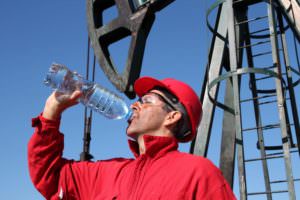
People depend on the products of your petrochemical plant. You have production schedules to meet, which means your plant has to work at high capacity no matter the weather. At the same time, you don’t want your employees to experience heatstroke. Heatstroke can not only kill your employees it can also open you up to lawsuits or expensive worker’s compensation claims.
Here are some tips to help you maintain productivity at your petrochemical plant while protecting your workers from heatstroke, including the role of an evaporative cooler.
If workers recognize when they or their coworkers are experiencing heat illness, they can take steps to stop it before it turns into heatstroke.
Warning signs to watch for include:
When people start to experience these effects, it’s essential for them to take breaks for cooling off and consuming water. When a worker experiences heatstroke, they may be confused or may pass out. Strangely, they may also stop sweating. If a worker is confused, collapses, or passes out from heat stress, call 9-1-1.
Two types of factors control when workers are at risk for heatstroke. There are hazardous location workplace risk factors, including the high temperature and/or humidity at the petrochemical plant, heavy physical labor, lack of ventilation, required protective clothing, and coverage with oily residues that can interfere with sweating.
In addition, there are personal risk factors. Workers who are over 65, overweight, have heart disease or high blood pressure, or take certain medications are at elevated risk.
The risk of heatstroke increases dramatically during the first days of work at high temperatures. When the temperatures climb, let workers take it easy for the first few days, with longer and more frequent breaks. Then gradually increase back to a normal workload.
Do this every time a worker returns from vacation or other extended breaks from work.
Along with acclimating, reschedule your work so that you do the most strenuous tasks during the cooler parts of the day. This might mean doing them first thing in the morning or during the overnight shift.
 You might think that your production schedule doesn’t allow you to build in additional breaks for overheated workers, but this is far better for productivity than having them work overheated.
You might think that your production schedule doesn’t allow you to build in additional breaks for overheated workers, but this is far better for productivity than having them work overheated.
Overheated workers are less productive and make more mistakes. This can lead to costly accidents that may cause employee injury, expensive damage to equipment, or product loss. And nothing will halt your operation faster than having an employee pass out at work in front of all their coworkers.
Workers need water to stay hydrated. Sweat is the only way a person’s body can cool down once temperatures reach 95°F. Sweat is mostly water leaving the body, so they need to replenish that lost water.
The recommendation is to provide one pint of water per hour. Encourage employees to drink water even if they don’t feel thirsty. They cannot substitute caffeinated beverages for water, and they should avoid alcohol during the day.
It’s essential to make sure the workplace stays well-ventilated. Ventilation lets hot air exhaust from the plant and improves the evaporation of sweat.
It’s not always possible or reasonable to cool the plant. Try to provide spot cooling in areas where there are sources of additional heat or where workers are laboring strenuously. Failing that, spot cooling can help create a comfortable rest spot that helps workers shed excess heat during breaks.
If you are looking for an effective cooling option for your petrochemical plant, consider Portacool. Our evaporative coolers can drive large amounts of cool air to lower the temperature in specific parts of your plant or cool the entire plant. Our hazardous location series is approved for use around combustible gases, with sealed electrical switches to make them safe for your petrochemical plant.
Please visit a local retailer or contact us today for a direct order.